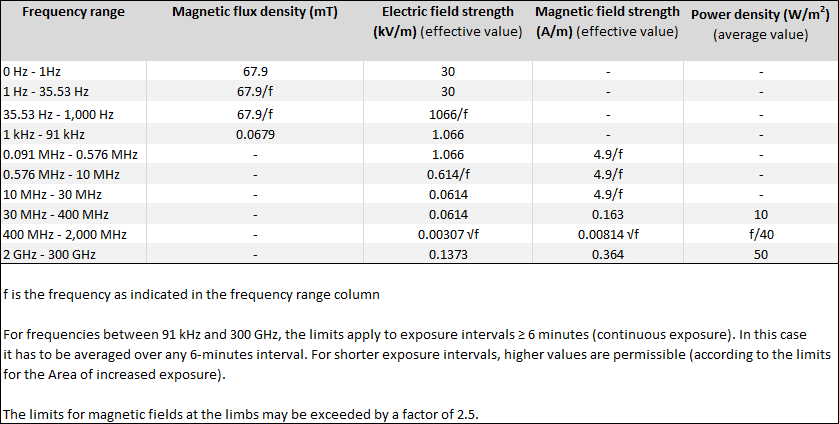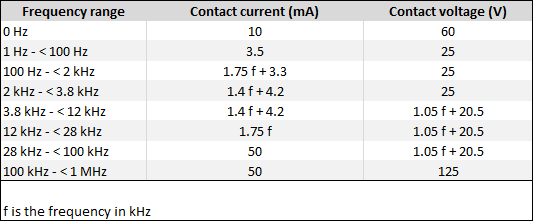Limit values in Germany (occupational exposure)
At workplaces, special regulations apply. Here the exposure limits for the general public can be exceeded. At European level, the Directive 2013/35/EU of the European Parliament and of the Council on the “minimum health and safety requirements regarding the exposure of workers to the risks arising from physical agents (electromagnetic fields)” came into force on June 26, 2013. The rules contained therein shall be implemented into national law by all EU Member States through corresponding laws, regulations or administrative provisions by July 1, 2016. The regulations are based on the recommendations of the International Commission on Non-Ionizing Radiation Protection (ICNIRP). In the directive, the following limits are specified in a number of tables for different frequency ranges from 0 Hz to 300 GHz:
- Exposure limit values to avoid health and sensory effects, and
- Action levels to ensure, by simplified assessment, the compliance with the exposure limit values at the workplaces.
Exposure to electromagnetic fields, contact currents and induced currents through the limbs are treated separately.
The protection of workers in Germany is mainly regulated by the Electromagnetic fields Accident prevention regulation (BGV B11) from June 1, 2001. Here, four different exposure areas are defined, in which higher exposures are permitted than those defined in the 26. BlmSchV for the general public:
- Exposure area 2 (all publicly accessible areas of the company, which are not assigned to one of the other exposure areas)
- Exposure area 1 (controlled areas and areas where the permissible exposure values of Exposure area 2 will be exceeded temporarily)
- Area of increased exposure (controlled areas where the permissible exposure values of Exposure area 1 are exceeded)
- Danger area (controlled areas where the permissible exposure values of the area of increased exposure are exceeded)
In the Accident prevention regulation, reference levels are defined for the different exposure areas. These reference levels have been calculated from the basic restrictions taking into account various safety factors (see table “Reference levels”). Even under worst case exposure conditions in the workplace, the reference levels are set in a way that the basic restrictions are not exceeded. Special rules apply for pulsed electromagnetic fields. The danger area has to be specially marked and secured. When carrying out work in this hazardous area, the wearing of personal protective equipment is mandatory and thus precludes impermissible exposures.
The employers must also take special measures to protect carriers of active and passive physical aids (e.g. pacemakers or metallic implants) from health hazards.
As an example, the reference levels in the different frequency ranges are summarized for Exposure area 1 in the following table.

In the frequency range from 10 MHz to 110 MHz, high-frequency currents may be injected in the human body, which may lead to the basic restrictions (SAR values in this case) being exceeded in the limbs. For this reason, in addition to the field strengths shown in the “Reference levels” table, a limit for currents through the limbs is defined in the BGV B11. The permissible value for injected high-frequency currents is 100 mA for Exposure area 1.
There are specific limits for the permissible contact currents and contact voltages in the frequency range from 0 Hz to 1 MHz (see following table; this applies to all Exposure areas).

For pulsed fields, a special assessment procedure applies; this is described in Annex 2 of the BGV B11. For workplaces at plants or devices with strong static magnetic fields, e.g. in the case of magnetic resonance imaging, specific limits according to the following table apply:

All regulations defined in the Accident prevention regulation BGV B11 will be replaced in the future by new laws, regulations or administrative provisions, because the above-mentioned EU Directive 2013/35/EU is to be implemented into national law by all EU Member States by July 1, 2016. The appropriate implementation is currently being developed in Germany.